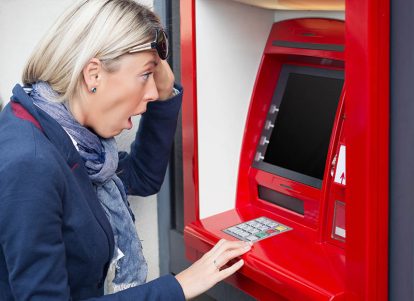What is a Negative Bank Account?

If you have a negative bank account balance, then this means that more money was taken out of the account than was available. Also known as an overdraft, a negative account balance can occur when a transaction against the account takes its overall balance below zero. Dropping a bank account’s balance into the red can be quite costly as many financial institutions implement steep fines for those who overdraft their available funds.
Causes of Negative Bank Account Balances
Negative balances can happen for a wide variety of reasons. Most of the time, overdrafts happen on accident because of unfortunate timing, but they can also be a symptom of a much larger financial issue that needs to be addressed.
For a negative account balance to occur, your account balance may not have updated immediately after a check was deposited or you may have forgotten the exact balance which was available in the account before making a purchase. ATM transactions, writing a check, withdrawing from a bank teller, and the billing of scheduled monthly payments are some of the most common reasons why overdafts occur.
What Happens When Your Bank Account is Negative?
When your bank account balance falls into the red, one of the three scenarios is most likely to play out.
- The bank covers the overbilled amount on your behalf and you’re charged an overdraft fee. This is the default outcome if your account has overdraft coverage enabled, and it will save you a declined transaction in exchange for the overdraft fee. If you continue to make purchases while your account balance is still in the red, some banks will continue to approve the transactions and continue to charge you overdraft fees to a limit. Overdraft fees are often quite steep and should be avoided whenever possible.
- Funds from another account may be pulled to cover the overdraft cost. This can happen when your account has overdraft protection enabled. If the linked account has the sufficient funds to cover the overdraft, it may do so automatically for a small fee with overdraft protection enabled. If a credit card is tied to the overdraft protection instead, you may be charged a cash-advance fee for the overdraft funds covered rather than it being charged to credit. According to a recent study from Financial Health Network, Americans paid over $12 billion in overdraft fees in the year of 2020.
- If you do not have overdraft coverage or protection, then the transaction will be declined. In most cases, a transaction being declined due to Nonsufficient Funds (NSF) will be accompanied by an NSF fee which can be a similar amount to an overdraft fee. So with this outcome, the transaction may be declined and you may owe the bank a small fee for trying to perform a transaction without the sufficient funds to do so.
How Long Can My Bank Account Be Negative?
Banks don’t tend to allow accounst with a negative balance to stay open indefinitely. If you’ve overdrawn from your account too many times or have let the account balance stay in the red for too long, the bank will most likely close the account. If the bank does close your account because of a negative balance, this action is reported as an involuntary account closure to one of the companies that keeps records on checking accounts. This can make it much harder to open a new bank account for years afterward as any records of such closures in your banking history are kept on your record for up to 7 years. Additionally, the debt owed from the negative balance does not simply disappear, and the bank will likely try to recover the debt through a debt collection firm or other method.
Can You Close a Bank Account with a Negative Balance?
When trying to close a bank account with a negative account balance, the bank can either accept or refuse. If the closure is denied, they will ask that you pay back the balance before the account can be fully closed. If they accept, the debt may be sold to a collection agency and this can have a negative effect on your credit score. In addition, the involuntary closure will be listed on your bank account history, potentially making it much harder to open an account without severe restrictions on it in the years after the closure.
How to Fix a Negative Bank Account Balance
The first thing you should do if you’ve overdrawn an account is to stop making purchases with that account. This includes stopping any automatic payments that may be tied to the overdrawn account. From there, you should get an understanding of how much has been overdrawn and the cost of any fees that may have accrued as a result. You can take these steps to figure out exactly how much could be owed for the negative balance:
- Browse your latest bank statements or online transaction history to get an idea of how much has been charged to the account & how much has been deposited into the balance.
- Look at each transaction in your bank account history to make sure you’re not missing out on anything that is still processing.
- Calculate the account’s true balance with all of the processing transactions as completed and the fees that may have been charged for overdraft or NFS (fees may not appear on the statement balance).
Next, it’s a matter of paying enough into the account to reverse the negative balance and all of the fees.
